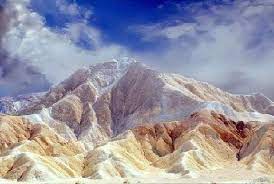Koh-e-Sulaiman, also known as the Sulaiman Mountains, is a long mountain range located in western Pakistan and eastern Afghanistan. The range extends for about 600 miles (970 kilometers) from the Kabul River in Afghanistan to the Indus River in Pakistan.
The Iranian plateau’s eastern edge is formed by them as they rise. They are situated in the Afghan provinces of Paktika, Zabul, and Kandahar. They cover certain southern portions of Khyber Pakhtunkhwa in Pakistan as well as the northern portion of Balochistan. The mountains stretch into the two districts of Dera Ghazi Khan and Rajanpur in southwest Punjab, which are situated west of the Indus River on the state’s border with Balochistan.
In history and mythology, “Koh-e-Sulaiman” or “Throne of Solomon” refers to a legendary mountain mentioned in Islamic and Jewish traditions, which is said to have been a favorite spot of the prophet Solomon for meditation and reflection.
The highest peak of the range is Takht-e-Sulaiman, which has an elevation of 3,487 meters (11,437 feet) above sea level. The Sulaiman Mountains are rich in mineral resources, including coal, copper, and natural gas, and they are also home to a diverse range of flora and fauna. The area has a rich cultural history, and there are many archaeological sites and ancient ruins in the region, including the famous Takht-e-Bahi monastery in Pakistan, which dates back to the 1st century BCE.
Which is the highest peak of the Koh e Sulaiman range?
It is close to both South Waziristan’s and Zhob, Balochistan’s borders with Dera Ismail Khan Subdivision. It is the tallest peak in the Dera Ismail Khan District and the larger Shirani area at 3,487 meters (11,440 feet). Takht-e-Sulaiman was referred to by Ibn Battuta as Kh-e Sulaymn, or the “Mount of Solomon.”
Click here for more Blogs
Click here for more information
Author: Nishat HaideR
 Shalkot The Innovators
Shalkot The Innovators




